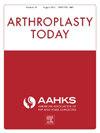Evaluation of a Mobile App to Assist Patient Education and Research in Arthroplasty
IF 1.5
Q3 ORTHOPEDICS
引用次数: 0
Abstract
Background
Paper-based patient-reported outcome measures (PROMs) and patient education can assist in improving outcomes but is administratively burdensome. Mobile phone applications (‘apps’) can distribute extensive information and PROMs at relevant time points. This study aimed to assess the suitability of an app to guide postoperative management and record PROMs based on satisfaction and compliance.
Methods
Thirty-four patients who were scheduled for a total hip/knee arthroplasty were enrolled into the study. Automatic notifications were sent by the app to complete PROMs at the appropriate time points. Patients were reminded via phone call if PROMs were not completed. An app satisfaction questionnaire was also completed, where a high score represented satisfaction with the app.
Results
Patients remained satisfied with the app throughout the study with a mean score of 19.0 out of 25. 57% found the app to be helpful with completing surveys, with 63% preferring the app over paper handouts. Majority of the participants (68%) stated that they would use the app again. There was an overall mean compliance of 78% at all time points. Most patients (82%) required at least one phone call reminder, with 18% of patients completing their PROMs prompted by the app notification alone.
Conclusions
A mobile phone app can be useful for both distributing patient education and collecting PROMs. PROMs collected using a mobile phone app still caused some administrative burden with many participants requiring multiple reminders to complete their questionnaires. While paper-forms will still be required for some patients, most found the app preferable to paper-form.
评估辅助关节置换术患者教育和研究的移动应用程序
背景基于纸张的患者报告结果测量(PROMs)和患者教育有助于改善疗效,但行政负担较重。手机应用程序("App")可以在相关时间点发布大量信息和 PROMs。本研究旨在评估一款应用程序是否适合指导术后管理,并根据满意度和依从性记录PROMs。应用程序自动发送通知,要求患者在适当的时间点完成 PROMs。如果患者未完成 PROM,则会通过电话提醒患者。患者还填写了一份应用程序满意度问卷,高分代表对应用程序的满意度。57%的人认为该应用程序有助于完成调查,63%的人认为该应用程序优于纸质问卷。大多数参与者(68%)表示他们会再次使用该应用程序。所有时间点的总体平均依从性为 78%。大多数患者(82%)至少需要一次电话提醒,其中 18% 的患者仅在应用程序通知的提示下就完成了 PROM。使用手机应用收集 PROMs 仍会造成一定的管理负担,许多参与者需要多次提醒才能完成问卷。虽然有些患者仍需要纸质表格,但大多数人认为手机应用比纸质表格更可取。
本文章由计算机程序翻译,如有差异,请以英文原文为准。
求助全文
约1分钟内获得全文
求助全文
来源期刊

Arthroplasty Today
Medicine-Surgery
CiteScore
2.90
自引率
0.00%
发文量
258
审稿时长
40 weeks
期刊介绍:
Arthroplasty Today is a companion journal to the Journal of Arthroplasty. The journal Arthroplasty Today brings together the clinical and scientific foundations for joint replacement of the hip and knee in an open-access, online format. Arthroplasty Today solicits manuscripts of the highest quality from all areas of scientific endeavor that relate to joint replacement or the treatment of its complications, including those dealing with patient outcomes, economic and policy issues, prosthetic design, biomechanics, biomaterials, and biologic response to arthroplasty. The journal focuses on case reports. It is the purpose of Arthroplasty Today to present material to practicing orthopaedic surgeons that will keep them abreast of developments in the field, prove useful in the care of patients, and aid in understanding the scientific foundation of this subspecialty area of joint replacement. The international members of the Editorial Board provide a worldwide perspective for the journal''s area of interest. Their participation ensures that each issue of Arthroplasty Today provides the reader with timely, peer-reviewed articles of the highest quality.
 求助内容:
求助内容: 应助结果提醒方式:
应助结果提醒方式:


